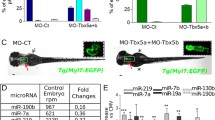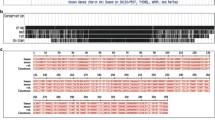Abstract
MicroRNAs are small noncoding RNAs that are important for proper cardiac development. In our previous study of fetuses with ventricular septal defects, we discovered that microRNA-375 (miR-375) is obviously upregulated compared with that in healthy controls. Our study also confirmed that miR-375 is crucial for cardiomyocyte differentiation. This research mainly focused on the biological significance and mechanism of miR-375 using a zebrafish model. We injected zebrafish embryos with 1–2 nl of a miR-375 mimic at various concentrations (0/2/4/8 μM) or with negative control. The deformation and mortality rates were separately assessed. The different expression levels of miR-375 and related genes were examined by qRT-PCR, and luciferase assays and in situ hybridization were used to clarify the mechanism of miR-375 during embryonic development. Overexpression of miR-375 disrupted the cardiac development of zebrafish embryos. Disruption of miR-375 led to a decreased heart rate, pericardial edema, and abnormal cardiac looping. Various genes involved in cardiac development were downregulated due to the overexpression of miR-375. Moreover, the NOTCH signaling pathway was affected, and the luciferase reporter gene assays confirmed notch2, which was predicted by bioinformatics analysis, as the target gene of miR-375. Our findings demonstrated that the overexpression of miR-375 is detrimental to embryonic development, including cardiac development, and can partially simulate a multisystemic disorder. MiR-375 has an important role during cardiac morphogenesis of zebrafish embryos by targeting notch2, indicating its potential as a diagnostic marker.






Similar content being viewed by others
References
Alabdulgader AA (2006) Congenital heart disease in Saudi Arabia: current epidemiology and future projections. East Mediterr Health J 12(Suppl 2):S157–S167
Alhoshani A, Alrashdi A, Alhosaini K, Alanazi FE, Alajez NM, Altaf M, Isab AA, Korashy HM (2018) Gold-containing compound BDG-I inhibits the growth of A549 lung cancer cells through the deregulation of miRNA expression. Saudi Pharm J 26(7):1035–1043
Arvidsson Y, Rehammar A, Bergstrom A, Andersson E, Altiparmak G, Sward C, Wangberg B, Kristiansson E, Nilsson O (2018) miRNA profiling of small intestinal neuroendocrine tumors defines novel molecular subtypes and identifies miR-375 as a biomarker of patient survival. Mod Pathol 31(8):1302–1317
Banerjee S, Hayer K, Hogenesch JB, Granato M (2015) Zebrafish foxc1a drives appendage-specific neural circuit development. Development 142(4):753–762
Banjo T, Grajcarek J, Yoshino D, Osada H, Miyasaka KY, Kida YS, Ueki Y, Nagayama K, Kawakami K, Matsumoto T, Sato M, Ogura T (2013) Haemodynamically dependent valvulogenesis of zebrafish heart is mediated by flow-dependent expression of miR-21. Nat Commun 4:1978
Bhardwaj R, Rai SK, Yadav AK, Lakhotia S, Agrawal D, Kumar A, Mohapatra B (2015) Epidemiology of congenital heart disease in India. Congenit Heart Dis 10(5):437–446
Bhatia V, Yadav A, Tiwari R, Nigam S, Goel S, Carskadon S, Gupta N, Goel A, Palanisamy N, Ateeq B (2018) Epigenetic silencing of miRNA-338-5p and miRNA-421 drives SPINK1-positive prostate cancer. Clin Cancer Res 25(9):2755–2768
Bhattacharya M, Sharma AR, Sharma G, Patra BC, Nam JS, Chakraborty C, Lee SS (2017) The crucial role and regulations of miRNAs in zebrafish development. Protoplasma 254(1):17–31
Bournele D, Beis D (2016) Zebrafish models of cardiovascular disease. Heart Fail Rev 21(6):803–813
Brownawell AM, Macara IG (2002) Exportin-5, a novel karyopherin, mediates nuclear export of double-stranded RNA binding proteins. J Cell Biol 156(1):53–64
Cao L, Kong LP, Yu ZB, Han SP, Bai YF, Zhu J, Hu X, Zhu C, Zhu S, Guo XR (2012) microRNA expression profiling of the developing mouse heart. Int J Mol Med 30(5):1095–1104
Chaitra KL, Ulaganathan K, James A, Ananthapur V, Nallari P (2013) miRNA regulation during cardiac development and remodeling in cardiomyopathy. EXCLI J 12:980–992
Clouthier DE, Hosoda K, Richardson JA, Williams SC, Yanagisawa H, Kuwaki T, Kumada M, Hammer RE, Yanagisawa M (1998) Cranial and cardiac neural crest defects in endothelin-A receptor-deficient mice. Development 125(5):813–824
Cordes KR, Srivastava D, Ivey KN (2010) MicroRNAs in cardiac development. Pediatr Cardiol 31(3):349–356
Dadvand P, Rankin J, Shirley MD, Rushton S, Pless-Mulloli T (2009) Descriptive epidemiology of congenital heart disease in Northern England. Paediatr Perinat Epidemiol 23(1):58–65
Dahm R, Geisler R (2006) Learning from small fry: the zebrafish as a genetic model organism for aquaculture fish species. Mar Biotechnol 8(4):329–345
Gao G, Tian Z, Zhu HY, Ouyang XY (2018) miRNA-133b targets FGFR1 and presents multiple tumor suppressor activities in osteosarcoma. Cancer Cell Int 18:210
Ghosh A, Ekka MK, Tawani A, Kumar A, Chakraborty D, Maiti S (2018) Restoration of miRNA-149 expression by TmPyP4 induced unfolding of quadruplex within its precursor. Biochemistry
Giraldez AJ, Cinalli RM, Glasner ME, Enright AJ, Thomson JM, Baskerville S, Hammond SM, Bartel DP, Schier AF (2005) MicroRNAs regulate brain morphogenesis in zebrafish. Science 308(5723):833–838
Goldmuntz E (2001) The epidemiology and genetics of congenital heart disease. Clin Perinatol 28(1):1–10
Gregory RI, Chendrimada TP, Cooch N, Shiekhattar R (2005) Human RISC couples microRNA biogenesis and posttranscriptional gene silencing. Cell 123(4):631–640
Gude NA, Emmanuel G, Wu W, Cottage CT, Fischer K, Quijada P, Muraski JA, Alvarez R, Rubio M, Schaefer E, Sussman MA (2008) Activation of Notch-mediated protective signaling in the myocardium. Circ Res 102(9):1025–1035
Hoffman JI, Kaplan S (2002) The incidence of congenital heart disease. J Am Coll Cardiol 39(12):1890–1900
Kamath BM, Bauer RC, Loomes KM, Chao G, Gerfen J, Hutchinson A, Hardikar W, Hirschfield G, Jara P, Krantz ID, Lapunzina P, Leonard L, Ling S, Ng VL, Hoang PL, Piccoli DA, Spinner NB (2012) NOTCH2 mutations in Alagille syndrome. J Med Genet 49(2):138–144
Karlsson J, von Hofsten J, Olsson PE (2001) Generating transparent zebrafish: a refined method to improve detection of gene expression during embryonic development. Mar Biotechnol 3(6):522–527
Kimmel CB, Ballard WW, Kimmel SR, Ullmann B, Schilling TF (1995) Stages of embryonic development of the zebrafish. Dev Dyn 203(3):253–310
Kloosterman WP, Lagendijk AK, Ketting RF, Moulton JD, Plasterk RH (2007) Targeted inhibition of miRNA maturation with morpholinos reveals a role for miR-375 in pancreatic islet development. PLoS Biol 5(8):e203
Li J, Yue Y, Dong X, Jia W, Li K, Liang D, Dong Z, Wang X, Nan X, Zhang Q, Zhao Q (2015) Zebrafish foxc1a plays a crucial role in early somitogenesis by restricting the expression of aldh1a2 directly. J Biol Chem 290(16):10216–10228
Li J, Yue Y, Zhao Q (2016) Retinoic acid signaling is essential for valvulogenesis by affecting endocardial cushions formation in Zebrafish embryos. Zebrafish 13(1):9–18
Li M, Hu X, Zhu J, Zhu C, Zhu S, Liu X, Xu J, Han S, Yu Z (2014) Overexpression of miR-19b impairs cardiac development in zebrafish by targeting ctnnb1. Cell Physiol Biochem 33(6):1988–2002
McDaniell R, Warthen DM, Sanchez-Lara PA, Pai A, Krantz ID, Piccoli DA, Spinner NB (2006) NOTCH2 mutations cause Alagille syndrome, a heterogeneous disorder of the notch signaling pathway. Am J Hum Genet 79(1):169–173
Meester JAN, Verstraeten A, Alaerts M, Schepers D, Van Laer L, Loeys BL (2019) Overlapping but distinct roles for NOTCH receptors in human cardiovascular disease. Clin Genet 95(1):85–94
Morton SU, Scherz PJ, Cordes KR, Ivey KN, Stainier DY, Srivastava D (2008) microRNA-138 modulates cardiac patterning during embryonic development. Proc Natl Acad Sci U S A 105(46):17830–17835
Porrello ER (2013) microRNAs in cardiac development and regeneration. Clin Sci (Lond) 125(4):151–166
Poy MN, Eliasson L, Krutzfeldt J, Kuwajima S, Ma X, Macdonald PE, Pfeffer S, Tuschl T, Rajewsky N, Rorsman P, Stoffel M (2004) A pancreatic islet-specific microRNA regulates insulin secretion. Nature 432(7014):226–230
Schoenebeck JJ, Yelon D (2007) Illuminating cardiac development: advances in imaging add new dimensions to the utility of zebrafish genetics. Semin Cell Dev Biol 18(1):27–35
Shaker OG, Mohammed SR, Mohammed AM, Mahmoud Z (2018) Impact of microRNA-375 and its target gene SMAD-7 polymorphism on susceptibility of colorectal cancer. J Clin Lab Anal 32(1)
Srivastava D (2006) Making or breaking the heart: from lineage determination to morphogenesis. Cell 126(6):1037–1048
Walton RZ, Bruce AE, Olivey HE, Najib K, Johnson V, Earley JU, Ho RK, Svensson EC (2006) Fog1 is required for cardiac looping in zebrafish. Dev Biol 289(2):482–493
Wang L, Song G, Liu M, Chen B, Chen Y, Shen Y, Zhu J, Zhou X (2016) MicroRNA-375 overexpression influences P19 cell proliferation, apoptosis and differentiation through the Notch signaling pathway. Int J Mol Med 37(1):47–55
Whittaker JR (1966) An analysis of melanogenesis in differentiating pigment cells of ascidian embryos. Dev Biol 14(1):1–39
Yi R, Qin Y, Macara IG, Cullen BR (2003) Exportin-5 mediates the nuclear export of pre-microRNAs and short hairpin RNAs. Genes Dev 17(24):3011–3016
Yue Y, Jiang M, He L, Zhang Z, Zhang Q, Gu C, Liu M, Li N, Zhao Q (2018) The transcription factor Foxc1a in zebrafish directly regulates expression of nkx2.5, encoding a transcriptional regulator of cardiac progenitor cells. J Biol Chem 293(2):638–650
Zhu S, Cao L, Zhu J, Kong L, Jin J, Qian L, Zhu C, Hu X, Li M, Guo X, Han S, Yu Z (2013) Identification of maternal serum microRNAs as novel non-invasive biomarkers for prenatal detection of fetal congenital heart defects. Clin Chim Acta 424:66–72
Acknowledgments
We thank Xiaohua Dong and all members of the Nanjing Maternal and Child Health Medical Institute laboratories for their assistance, invaluable support, and discussion.
Funding
The study was supported by grants from the Jiangsu Province Natural Science Foundation of China (Grant No. BK20130076) and the Natural Science Foundation of China (Grant No. 81501262 and 81670900).
Author information
Authors and Affiliations
Contributions
SS Z, YR F, JY L, MM L, XS H, JG Z, and ML T conceived and designed the experiments. SS Z and YR F and JY L conducted the experiments, collected and analyzed the data, and wrote the manuscript. JG Z and ML T edited all the manuscript.
Corresponding authors
Ethics declarations
Ethical approval
All applicable international, national, and/or institutional guidelines for the care and use of animals were followed.
Conflict of interests
The authors declare that they have no competing interests.
Additional information
Handling Editor: Reimer Stick
Publisher’s note
Springer Nature remains neutral with regard to jurisdictional claims in published maps and institutional affiliations.
Rights and permissions
About this article
Cite this article
Zhuang, S., Fu, Y., Li, J. et al. MicroRNA-375 overexpression disrupts cardiac development of Zebrafish (Danio rerio) by targeting notch2. Protoplasma 257, 1309–1318 (2020). https://doi.org/10.1007/s00709-020-01490-4
Received:
Accepted:
Published:
Issue Date:
DOI: https://doi.org/10.1007/s00709-020-01490-4




